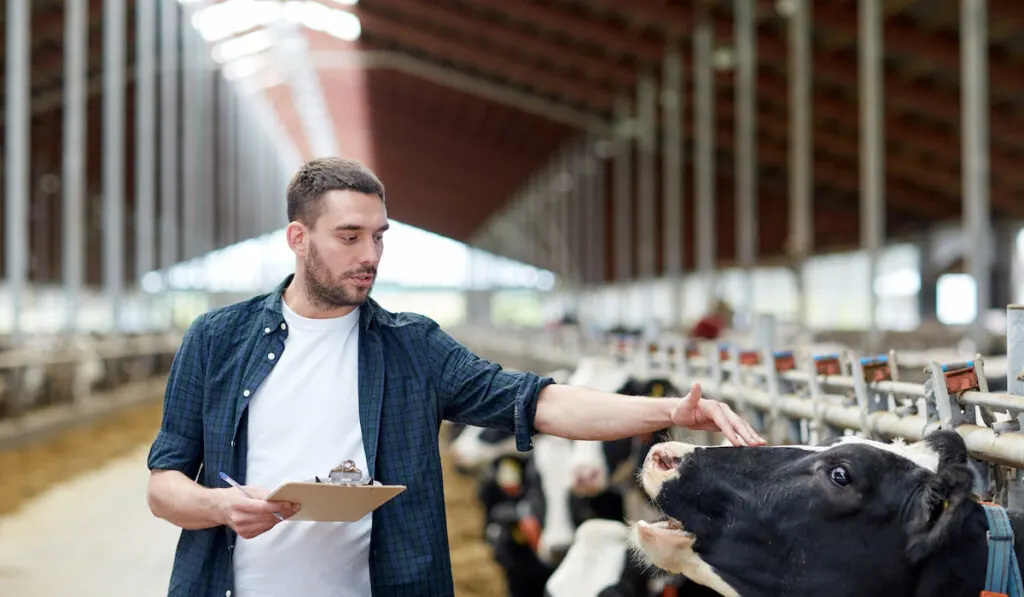Summers can sometimes get too hot, leading us to activities like eating ice cream or swimming.
But the high humidity and temperature affects not only humans but also the health and productivity of cows. The optimal surrounding temperature for cattle is 25°F-65°F (-3.8°C-18.3°C), with humidity levels below 20%.
When these levels rise above 80°F (26.6°C) and 50% humidity, they trigger heat stress. You can tell when temperatures are too high for your cows if:
- They breathe and pant with open mouths and extended necks, keeping their heads low
- They look lethargic and unsteady.
- There is a rise in body temperature above 102.6°F (39.2°C)
- There is a decline in milk production in dairy cows
- They show a decrease in feed intake.
- They are less active.

Also, you can tell how stressed your cow is by observing the breathing rate. The table below shows the relationship between a cow’s breathing rate and stress.
| Breathing rate per minute. | Stress category. |
| Below 90 breaths | No stress |
| 90 to 110 breaths | Alert |
| 110 to 130 breaths | Danger |
| More than 130 breaths | Emergency |
Here are nine tips to help keep your cows cool in summer:

Table of Contents
1. Build Shade Over the Pasture Area
Providing shade for your cattle minimizes heat stress. It keeps cows cool by shielding them from direct sunlight. And this can help lower heat by about 30%.
Trees provide the best natural shade for your animals.
But in the absence of trees, you can construct a permanent or makeshift shade over the feeding area. Installing a shelter will allow your cows to feed during hot weather.

2. Give Them Plenty of Water
Cows require nearly 2 gallons of water per 100 pounds (45 kilograms) of body weight in hot weather compared to 1 gallon per 100 pounds (45 kilograms) in cooler weather.
Ensure you provide your cattle with sufficient clean and cool drinking water.
The suitable average water temperature for cattle consumption is 40°F to 65°F (4.4°C to 18.3°C). They take less water when temperatures rise beyond 80°F (26.6°C). You can cover water pipes with grass and build shades over the water to help keep it cool.
Water helps cool the cow’s body in many ways, including:
- During ingestion
- While breathing
- When sweating
- When passing urine
- During excretion

3. Install Sprinklers in the Feeding Area
Sprinklers help reduce heat on cows using evaporation. You can install them over your feed alley about 8 feet above the ground. They spray water over the cows’ backs at set intervals. The intervals allow the water to soak the cows’ skins and evaporate, cooling the animals.
4. Use Cooling Fans
Fans can also help cool your cows in summer. You can set them to run on a thermostat to start when temperatures rise automatically. Fans help ventilate barns; they speed up the evaporation of sweat from cows’ skin.
You can also use fans with sprinklers to aid in evaporating water. If you combine them, they can be your barn’s best cooling mechanism. As mentioned earlier, evaporation helps cool the animals’ bodies.

5. Make Dietary Changes
Metabolic activities produce heat in animals. And during hot weather, cows automatically cut down feed intake to reduce metabolic heat production. Reducing intake is a protective action to regulate body temperature.
However, decreased dry matter intake (DMI) significantly reduces milk production. Different feedstuffs produce varying levels of metabolic heat. For instance, fiber produces more metabolic heat than dietary fats and concentrates.
Therefore, diets rich in dietary fats and high-quality forages can be helpful to your cattle in hot weather. The cows will have low metabolic heat production and sufficient DMI.
Moreover, you can switch to feeding at night if nights are significantly cooler than days. But it is safer to consult your vet before making animal diet changes.

6. Do Not Overcrowd the Holding Pen
Most often, the holding pen is densely populated. The limited space makes it difficult for the cows to radiate heat. As a result, they transfer heat between themselves.
Make sure you move fewer cows to the holding pen during milking to reduce the holding time. In addition, you can install sprinklers and fans in the holding pen to minimize the risk.
7. Use Tunnel Ventilation and Cooling Cells
Tunnel ventilation combined with cooling cells is among the most efficient cooling methods.
Adequate ventilation can reduce the temperature in your barn by nearly 10 degrees below the surroundings.
However, this system is only feasible and cost-effective for small-scale farms.

8. Avoid Adding to the Stress
Avoid transporting, sorting, or vaccinating your cattle on hot days unless your vet advises. If you have to, then handle them early in the morning in a less stressful way. Vaccines specifically add stress to the cows’ immune systems.
Moreover, you should treat dry cows more carefully to prevent stress-induced abortion.

9. Monitor Them Constantly
During summer, cows may show different signs in reaction to high temperatures. Symptoms will vary; it can be unusual breathing or reduced milk production. You can detect the signs early and take action if you monitor your cattle closely.
One of the best ways to monitor temperatures is by fitting your cows with temperature-monitoring devices. Also, regular checks by your vet can help identify and address health problems.
Final Thoughts
As a dairy farmer, you can take many courses of action to cool cows in the summer. Although these interventions are critical in hot weather, your cattle need all-year-round care, it shouldn’t be summer alone. Follow up on vaccinations and diet and ensure that they are comfortable.
Proper care will improve your animals’ health and productivity.
Resources
- https://www.canr.msu.edu/news/heat_stress_cattle_tips_to_keep_your_cattle_cool
- https://extension.missouri.edu/publications/g3620
- https://extension.umn.edu/dairy-milking-cows/heat-stress-dairy-cattle
- https://www.extension.iastate.edu/dairyteam/files/page/files/
- https://www.ag.k-state.edu/outreach/ffa/Heat
- https://dairy-cattle.extension.org/feeding-and-nutrition-management-for-hot-weather/
- https://beef.unl.edu/amountwatercowsdrink
